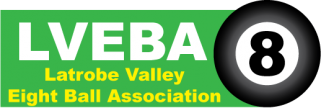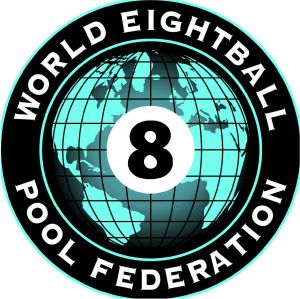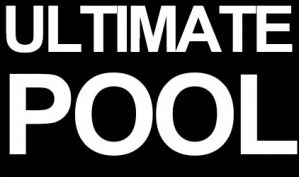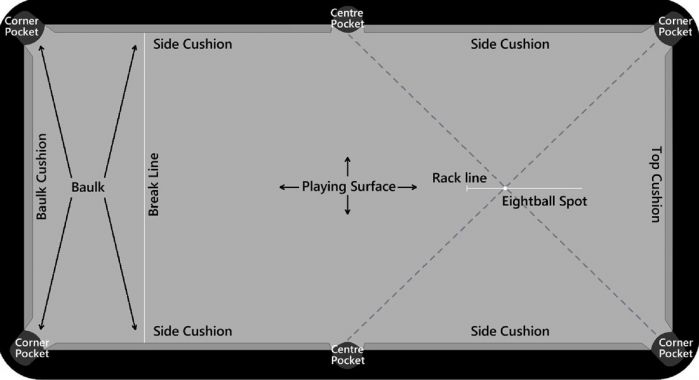1. SPIRIT OF THE GAME
The game shall be known as 'International Eightball Pool' with rules that must be played in a sporting manner at all times.
2. EQUIPMENT & TABLE LAYOUT
Equipment permitted:
(a) A spotted white called a cue ball
(b) Two groups of object balls consisting of seven reds and seven yellows
(c) A striped eight-ball
(d) Spider, rest, gooseneck rest, cross rest
(e) Prescribed cues
If any standard equipment as described in "Equipment permitted (d)" above is unavailable, the referee should stop the match to retrieve a set from the senior referee or tournament director. That being said, such equipment should be available before a match commences and a referee should make part of his/her duties. Players are permitted to use their own purpose-made equipment, but it must be authorised by the senior referee or tournament director prior to playing in the competition.
Players must be made aware before the commencement of a match that the shot clock will be running at all times if they wish to collect and use/put back any equipment that they are supplying themselves. This includes rests, cues, cue extensions, chalk, hand towels etc.
Should a tip fall off a player's cue, the referee will call a halt to the match for the player to speak with the senior referee or tournament director as to the length of time they have to re-tip the cue. Referees and players should always be made aware of tournament rules of which re-tipping a cue may be included. Should a falling tip make contact with any ball on the table, then a standard foul will be called.
In the event that the table is incorrectly marked, the match should move to another table. If there are no tables available the match should be rescheduled. If all other tables available are marked incorrectly, then the match must either be played on an incorrectly marked table on the understanding both players agree. This also applies to damaged tables.
If there is no eight-ball spot marked on the playing surface and no table engineer is onsite, that can assist with making table alterations, the referee shall align the rack of balls so that that eight-ball is in a direct line from the centre pocket to the opposite corner pocket at the top end of the table, as shown above in the table diagram.
3. OBJECT OF THE GAME
The match referee will enforce the flow of any given match to the extent that it is being played in accordance with the strict process by which a frame is won by any player. A player must adhere to the same strict process also.
4. THE LAG
Referees should ensure that there are no other balls or the racking triangle on the table when the lag is about to commence. The players should have access to the full top rail to hit and not be restricted.
The referee has the right to swap players over if one is left-handed and the other is right-handed so as not to impede the cueing for either player. As a rule, the right-handed player should lag to the left of the table and the left-handed to the right.
Balls used for the lag should be prescribed in the following order:
Two cue balls or a red and a yellow ball.
Do not use a cue ball and a group colour mixed because of the different sizes and weights.
The players shall simultaneously strike balls on the referee's indication towards the top cushion, this is deemed as guidance as to what should happen. If one player hits their ball and strikes the top cushion before the other player's ball is hit (not simultaneous), both players will re-lag.
4. THE BREAK
When calculating the number of points scored on the break, the referee should ensure that any balls counting should be:
(a) Completely over the imaginary line drawn between the centres of the two centre pockets.
(b) Pocketed.
Remembering any object ball that fully passes the centre line AND is pocketed only counts as 1 point.
Referees should take care in ensuring that, any object balls are not counted twice. For example, an object ball can pass the imaginary centre line, hit the baulk cushion, hit the top cushion and return back over the centre line. This can be also said for balls that pass the centre line, hit a cushion and are kicked/contacted back over the centre line for a second time.
5. THE RACK
When a referee is officiating, players are not permitted to rack the balls or check the rack after the triangle (or another racking device) has been removed.
Players are expected to rack their own balls when no referee is present.
Referees should ensure that the eight-ball is racked on the eight-ball spot.
Referees are permitted to use their discretion when racking in situations where the balls are not tight enough or the head ball rolls away from the rack. In this instance, a
referee should proceed to rack the balls marginally higher or lower to a maximum of 25mm or 1 inch (half an object ball's diameter).
A referee must ensure that the balls are racked in accordance with the correct sequence as shown below.
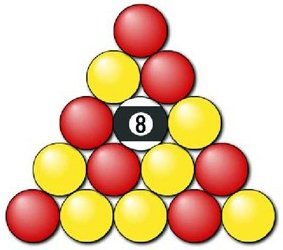
Players are not permitted to check any rack 'close-up' prior to commencing the frame. If they can see an obvious issue from where they are standing at the baulk end of the table, they must inform the referee immediately.
6a. DECIDING COLOURS
DEFINITION: During an 'open table', an 'obvious' object ball that the cue ball makes initial contact with first, becomes the ball "on".
At any time during an 'open table', If a player pots an obvious object ball, deemed as the ball 'on' and the shot doesn't result in a foul, they will be advised of their group to continue with, verbally by the referee, after all the balls have come to rest.
Whilst the table is 'open', if a player attempts to play an obvious object ball but misses it completely and cue ball proceeds to pot another ball in the same group they initially attempted, it would result in the player continuing on that group. However, if the ball potted was the opposite group, this would result in a 'loss of turn'.
The referee should not request a group nomination, when a nomination is required, this could be considered as coaching. Should a player call a group when the table has an obvious layout, the referee will call 'No nomination required'.
Whilst the table is 'open', it is not permitted to use the eight-ball as a ball 'on'.
Once the groups have been decided, players cannot ask what group they are on as this would be deemed coaching.
6b. CONTINUING A FRAME
A player is deemed to be 'in control' of the table from the time all the balls stop moving from the final shot of their opponent's visit, to the time all the balls stop moving from the final shot of their visit.
6c. COMBINATION SHOTS
All attempted combination shots that fail to pot both the ball 'on' and an opponent's group will result in a loss of turn which will be called as such, by the referee.
Potting the eight-ball and then an opponent's ball(s) is deemed a legal shot and no penalty is awarded.
6d. LOSS OF TURN
Potting an opponent's ball(s), without potting the ball 'on', having hit the ball 'on' first, will result in a loss of turn. The opponent plays the cue ball from where it lies. Examples of this are an unsuccessful combination shot or playing a tactical/turnover shot.
If on an 'open' table, a player makes an obvious attempt (no need to nominate) to hit a specific group and misses it completely (no contact) and proceeds to pot the opposite group, the referee shall call 'loss of turn' and the table remains 'open'.
If on an 'open' table, a player strikes the cue ball and makes initial contact with one group and the shot progresses into potting the opposite group only, the referee shall call 'loss of turn' and the table remains 'open'.
If on an 'open' table, the group the player intends to play is not obvious, a nomination of a group is required. For example, this could be that the player is playing towards a cluster of balls or a ball(s) of each group that are in close proximity to each other or fails to nominate a group on an 'open' table when a touching ball has been confirmed. After the shot is played, the referee shall call 'loss of turn' and the table remains 'open'.
If on an 'open' table, no referee present, a player calls one group, but intentionally plays the opposite group to try to force the loss of turn, the player will continue on the group potted. You cannot use the nomination rule to force a 'loss of turn'.
6e. STANDARD FOULS
As the rule states: "Shall be called as soon as they occur, the fouling player is in control until all balls from that shot have come to rest. The incoming player is awarded one visit and a cue ball in hand, which can be:
a) Played from its current position, or
b) Placed anywhere on the playing surface.
The only exception to (a) is If the cue ball has come to rest and is touching an object ball and therefore must be repositioned."
If a player receives a cue ball in hand following a foul and the cue ball is touching an object ball, if the cue ball is NOT repositioned and the player plays a shot, a standard foul is given to the opponent under rule 6e (7) "Playing a shot before any balls that require re-spotting or replacing, have been re-spotted or replaced".
With a referee present:
The instant the referee is aware of a foul, they will make the appropriate call. When all balls have stopped moving they will call the appropriate penalty. The referee will endeavour to recover the cue ball, offer it to the incoming player or place it on the playing surface against the baulk cushion and call "Time Running".
However, if the incoming player has requested the cue ball to be left in position following a foul, the referee will immediately call "Time Running" and the player is still free to pick up the cue ball at any point.
Following an "In-off", the referee or the player may recover the cue ball from the return box. The referee will call "Time Running" the moment the player's hand is in the return box, even if the cue ball has not arrived in the return box yet. If the player takes their time in recovering the cue ball from the return box, the referee will recover the cue ball, place it on the playing surface against the baulk cushion and call "Time Running".
With no referee present:
Once the foul is acknowledged by the player who committed the foul, the incoming player can then proceed to pick up the cue ball or play it from its current position.
A loss of frame foul, as per rule 6f (9) will be awarded if:
The player who committed the foul passes the cue ball to the incoming player, or, The incoming player moves the cue ball before any acknowledgement of the foul.
The referee or an opposing player must not stop a player who may be about to commit a foul, this action must take its course naturally and a foul is called if committed. If two or more fouls are committed in the same shot, the foul that carries the most severe penalty will be called.
6e (1) - The cue ball falls into a pocket and remains off the playing surface is defined as 'in-off'. If the cue ball hits the back of the pocket and then returns to the table, this is NOT an 'in-off'.
6e (2) - A player who positions the cue ball over the break line by more than 50% of its diameter.
6e (3) - Should a player play a shot, when they do not have the right to do so, will be deemed as playing out of turn. This can apply at any time during a frame.
6e (4) - A player may position the cue ball with the shaft of the cue when they have 'ball in hand'. The tip is the only part of the cue that can strike the cue ball in order to perform a legal shot. If the referee thinks that a player has deliberately breached this rule, they should consider if the spirit of the game has been breached, see rule 6f (2).
6e (5) - Accidentally striking any object ball with any part of the cue, including the tip, will be a foul. If the referee thinks that a player has deliberately breached this rule, they should consider if the spirit of the game has been breached, see rule 6f (2).
6e (6) - No further advice needs to be given.
6e (7) - No further advice needs to be given.
6e (8) - Referees should be sure that the words/actions can be interpreted as coaching. Should suspected coaching cause a player to visibly alter their shot or change how they are looking at the table or if there is a definite instruction, the referee will issue a first and final warning, if one has not been given already.
6e (9) - If a player wishes to leave the arena, for a bonafide reason, they must gain permission from the referee (or opposing player if there is not a referee present). Referees should not agree to excessive comfort breaks, the actual amount may be dictated by the competition/tournament rules. Leaving the arena during a frame (other than above) would not be allowed, in general, unless the player has agreed with the tournament director for example a medical reason.
6e (l0) - A push shot can be determined:
When the cue ball, having struck the object ball follows the object ball in a similar direction AND at a similar speed, when in close proximity to each other before the shot commences OR after the cue ball has commenced its forward motion and the tip of the cue is still in contact with the cue ball.
6e (11) - Seeing the cue follow through and/or hearing the double contact is not sufficient to make a call. It has to be a visible contact to make the call.
6e (l2) - See rule 6p 'Legal Shot' for definition. Potting or hitting your opponent's ball first, for example, when coming out of a snooker would be deemed accidental unless it was clear and obvious the shot played was deliberate, therefore carrying a greater penalty of 'loss of frame'.
6e (l3) - The player must always have at least one foot on the floor, defined as the sole of the shoe touching the floor. The player's foot must be within the shoe and not out of the shoe and on top of it.
6e (l4) - See rule 6o 'touching balls' for further guidance.
6e (l5) - See rule 6l 'balls off the table' for further guidance.
6e (l6) - No further advice needs to be given.
6e (l7) - A 'jump shot' refers to the action of the cue ball upon first striking, if the cue ball jumps the object ball being played, but hits that ball on the back, this is not a jump shot, the cue ball must completely jump over the object ball. If the cue ball were to completely clear the object ball, but, hit a cushion and return to hit the object ball it jumped, this is a jump shot. Similarly, if the cue ball's first contact is with a cushion, then jumps an object an object ball, this is also a jump shot. Once a shot has been played and the cue ball's first contact is with the ball intended, if any balls are jumped either by the cue ball or any other ball after this contact, these are not regarded as jump shots.
6e (l8) - If a player deliberately marks the playing surface or cushions in an effort to assist a shot, this is a standard foul. The marking could be with chalk on the cue tip or by finger mark or placing a block of chalk or a coin in a strategic position etc. The referee should endeavour to remove any marks or items. Should a player persist in doing this, a breach of the spirit of the game should be considered.
6e (l9) - See rule 6j 'shot clock' for further guidance.
6f. LOSS OF FRAME FOULS
6f (l) - Prohibits deliberately striking your opponent's ball first, this does not include accidents (miscues, miss of a fine cut).
6f (2) - Not playing in the spirit of the game (unsporting behaviour), for example (but not limited to):
(a) Audible bad language for a second time after being warned.
(b) Excessive hitting the table, physically or with a cue.
(c) Dismantling a cue or placing a cue in its case.
(d) Constant arguing with the referee (refusing to accept the referee/senior referee's decision) or opponent.
(e) Gamesmanship - Attempting to interfere with the opponent's shot, either verbally or physically. This could include jangling coins in their pocket, noisily chalking a cue, moving about in an opponent's eye line or making audible comments.
(f) Repeatedly marking the table.
(g) A player making a deliberate attempt to stop the cue ball from going 'in off' by any means possible. Just because a player thinks something is about to happen (i.e An 'in-off') they cannot assume it will as an outcome (i.e The cue ball could jump back out of the pocket).
6f (3) - No further advice needs to be given.
6f (4) - No further advice needs to be given.
6f (5) - Prevents you from refusing to play a shot (this includes a deliberate time fail, but not any time foul - it must be deliberate) or playing a deliberate foul instead of making a legitimate attempt to escape a snooker.
If you attempt a shot at the ball 'on' but leave the cue ball way short of the attempted ball 'on', the referee has the right to call it a deliberate act to leave the ball short, potentially so as not to disturb other balls near your ball 'on' in order to gain an advantage. Alternatively, you could read it this way:
"A player who makes an attempt to play a ball(s) 'on' but clearly and intentionally falls short of making contact with the ball(s) 'on' in order to gain a potential advantage".
If you are unable to come to a definitive conclusion regarding the shot to which you must rule upon, for the purposes of determining a 'loss of frame', your course of action should be in the first instance to warn the player that you cannot be sure 100% that it was a poor enough attempt and if they play a similar shot again then you will call 'loss of frame'.
6f (6) - No further advice needs to be given.
6f (7) - No further advice needs to be given.
6f (8) - No further advice needs to be given.
6f (9) - No further advice needs to be given.
6g. STALEMATE
Players must always ask for a stalemate if they believe one exists. When deciding a stalemate the rule is clear, "if there is no path 'out' for the cue ball or no path 'into' the ball 'on' in order to play a legal shot, a stalemate is given".
Regardless of how ridiculous an escape may be, the shot to play is never impossible but improbable. A referee will not apply the 'laws of physics' or take into account a player's ability, any judgement is solely based on the rule.
6h. FROZEN BALL(S)
For the purpose of frozen balls, there are six cushions: Baulk cushion, Top cushion, left-hand side top cushion, left-hand side baulk cushion, right-hand side top cushion and right-hand side baulk cushion.
If the frozen ball, upon being struck, leaves the cushion it was touching and then returns to the same cushion, without touching another cushion, this does NOT constitute a legal shot, unless:
(a) The frozen ball makes contact with an object ball forcing the object ball into a cushion or
(b) The cue ball makes contact with the cushion after contact with the frozen ball or
(c) The cue ball, after contact with the frozen ball, fails to make contact with a cushion but makes contact with an object ball forcing the object ball into a cushion. A simultaneous contact between a 'frozen ball' and the cushion it is frozen onto is NOT a legal shot.
If both the object ball and cue ball are frozen to the same cushion, then:
(a) A ball 'on' must be potted or
(b) Either the cue ball or frozen ball must contact a different cushion or
(c) Any other object ball must be caused to contact any cushion.
6i. OUTSIDE INTERFERENCE
No additional guidance is required. Everything stated in the rules is clear and concise. The only thing to note is that if it was a deliberate act to interfere, the players and spectators will be given a first and final warning and if it happens again the said person will be disqualified from the competition or removed from the venue.
6j. SHOT CLOCK
All calls will be made in a clear and audible manner for the benefit of both players and spectators.
A 'time foul' is called by the referee when the audible signal is heard for zero on the shot clock AND the player fails to make contact with the cue ball. If no audible signal is present and a manual stopwatch is being used, the timekeeper will call 'time foul' at zero.
If the referee has any doubt regarding the closeness of any time foul call, they should consult TV replays from the TV production crew (if available) or give the benefit of the doubt to the player at the table.
If a 'time foul' is called, the shot clock or stopwatch will not be reset and started for the incoming player until 'time running' is called.
If there are balls to be re-spotted, for whatever reason, the shot clock will not start until the referee calls 'time running' with both players remaining in their respective seats until the call is made.
If a match has access to a VDU (visual display unit) for the purposes of displaying the match score, shot clock and shot clock extension etc, the player should not be penalised if the timekeeper fails to update the relevant information or if there is a computer malfunction. A player will use the on-screen information when at the table to help determine which shot to play in most cases.
Stopwatch (if used) - timekeepers will not spend an inordinate amount of time staring at the stopwatch, to the detriment of their other duties.
Stopwatch (if used) - Should the five seconds call be made late, for whatever reason, the player will still be awarded five seconds from the time the call is made. At some point, the referee may need to concentrate more on a situation on the table rather than the stopwatch but should be aware of how much time is remaining.
The instant the referee decides that all balls have stopped moving, the shot clock for the incoming player will normally commence. The shot clock will stop the moment the cue ball is struck.
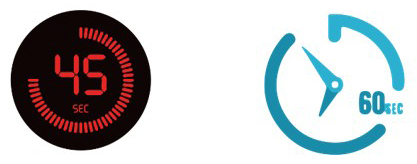
6k. BALLS FALLING IN A POCKET
The instant the that all balls have stopped moving, the shot clock for a player will commence.
Any balls that drop before a shot commences will be replaced back to their original position. The referee may have to call a 'timeout' to do this especially if you are using a shot clock. A player should not be penalised by losing time on the shot clock if such should occur and the shot clock should be paused and started once the referee calls 'time running'.
Any balls that drop during a shot, when not played as part of the shot or would have been played but dropped before contact, shall be replaced. The player will then carry on with no penalty. The only difference is if the ball that dropped would have been played as part of the shot, all the balls will be replaced to their original positions, not just the dropped ball. So effectively this means you are resetting the original shot for the player to either attempt the same shot again or choose a different shot, with no penalty.
If the match is being broadcast you can have the option to consult the production crew for a freeze frame of the positions of the balls. If both players are not satisfied with the positions of the balls, the referee must make further attempts to satisfy the players. A re-rack can only be granted by the referee if they feel they are unable to return the balls to their original positions. A player cannot enforce a re-rack, it could be seen as advantageous if they were in a worse position than their opponent.
6l. BALLS OFF THE TABLE
The playing surface of the table will be regarded as the flat surface between the cushions.
At ANY point during a frame (break or 'in play') if a ball leaves the playing surface and fails to return of its own accord, the ruling is a standard foul and the ball(s) respotted. This scenario and outcome are covered in rule 6e (15), rule 6l and rule 6m.
Any ball that leaves the playing surface must return to the playing surface of its own accord. If it contacts an object (that is not part of the table) or person and then returns to the playing surface, a 'standard foul' will be called.
If the ball leaves the playing surface and then runs along a cushion and then returns to the playing surface (or potted if a ball 'on') then this is not a foul.
Any ball(s) will be deemed as 'pocketed' if:
(a) They fall into a pocket or
(b) They reside over a pocket in such a way that even though the ball(s) are touching the playing surface the centre point of the ball is over the pocket and not on the playing surface. The example below gives a visual demonstration.
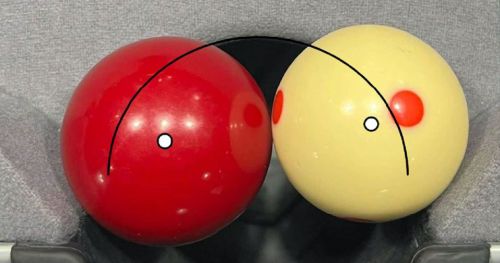

6m. RETURNING OBJECT BALLS WHICH LEAVE THE PLAYING SURFACE THAT REMAIN OFF THE TABLE
Object balls that remain off the table will be returned to the playing surface on the eight-ball spot or as close as possible to it in a direct line towards the top cushion. If there is no space between the eight-ball spot and the top cushion the ball(s) shall be placed in a direct line towards the eight-ball spot and the baulk cushion. When re-spotting balls they must be placed as close as possible to any other balls without touching them.
When returning multiple balls, they have an order of preference, eight-ball first, red balls second and then yellows.
6n. PLAYERS' RESPONSIBILITY
Should a player request clarification of a rule, the referee must be fully aware of whether the information they are about to provide will have an effect on the particular shot that the player may be considering playing. The choice of shot is the player's responsibility and the referee's advice cannot affect the outcome of a shot or frame. Referees must be careful that any clarification given cannot be construed as coaching. Should a player request clarification, they will do it in their own time, a time-out will not be granted.
It is a player's responsibility not to approach the table when a 'time-out' is called. This would be seen as gaining an advantage while no shot clock countdown is in progress. In the first instance, the referee should warn the player and ask them to remain seated. Persistent disregard of this warning, should the player do it again then the referee is within their right to award the frame to the opposing player for gamesmanship (Not playing in the spirit of the game/unsporting behaviour), See rules 6f (2).
6o. TOUCHING BALLS
A referee (or player if no referee is present) shall call all touching balls.
A player must play away from 'ALL' touching balls at an angle of perpendicular (90 degrees) or greater.
Any touching ball that rocks or moves slightly because it was 'resting' on the cue ball shall not result in a foul if played away at an angle greater than 90 degrees.
Touching ball(s) on an 'open' table requires a player to call a group for the purpose of clarifying the intended shot. Any call will not enforce the group choice for the rest of the frame, that can only be done from the first legal ball potted. If no call happens then regardless of the outcome of the shot, a 'loss of turn' is called.
6p. LEGAL SHOT
A player must always make an attempt to play a 'legal shot' regardless of the situation they are faced with.
In short, two elements are needed to fulfil a 'legal shot':
(a) Strike the ball 'on' first AND THEN
(b) Pot a ball or another ball indirectly (with the exception of the eight-ball if not 'on') OR cause the cue ball or any object ball (including the eight-ball if not 'on') to contact a cushion.
During an 'open table' the ball 'on' is the first ball you contact for the purposes of fulfilling the requirements of a 'legal shot'.
For the purposes of 'contacting a cushion' to perform a required element of a 'legal shot', these include the six pockets of a pool table. The reason for this is to mitigate objects balls that are potted and proceed to jump back out onto the playing surface without any ball actually contacting a cushion.
6q. SIMULTANEOUS CONTACT
Simultaneous contact is allowed as long as one of the contacted object balls is 'on'.
For simultaneous contact to happen during an 'open table', a player must have nominated a group because the choice of shot is not obvious as stated in rule 6a (5) AND also the nomination declares the intended group as the ball 'on' for the clarity of the shot. The referee would call 'loss of turn' as stated in rule 6d (4) if no nomination was forthcoming before the shot was played.
7. COMPLETION OF A FRAME
The frame is completed when a player pockets the eight-ball legally and all the balls have come to rest. The referee should call 'Frame' as a verbal indication that the frame has finished. At this point, a referee should proceed with the normal steps required for starting a frame of pool or to allow the players to take a comfort break. The referee can also use this period to speak with the senior referee on a matter that needs discussing or clarifying but must inform the players beforehand of their intention to do so.
During a timeout or stoppage in play, neither player is regarded as being in control of the table and referees should ensure that both players are stood away or sitting down away from the table.
Should a player take a shot or involve themselves in the frame, during a timeout, they are deemed to have played out of turn and a standard foul is called.
Timeouts or a stoppage in play will be at the referee's discretion.
(a) When a player requests a rest or bridge.
(b) Something or someone is obstructing the player.
(c) The referee has to make a decision or call in a senior referee.
(d) The referee has to replace or re-spot a ball.
(e) A player sustains an injury that requires medical attention or a few minutes to 'shake off' the injury in order to continue to play.
Some of these time-out requests listed above can be overruled by a tournament/competition ruling, a referee must be aware of all the tournament/competition rulings that are required for the purposes of refereeing.
(a) Cleaning of a ball (Can be done but in the player's own allotted time)
(b) A player requesting a toilet break.
(c) Searching for any item that a player has dropped.
(d) A player requesting to fetch refreshments.
When the cue ball, having struck the object ball follows the object ball in a similar direction and at a similar speed, when in close proximity to each other before the shot commences
After the cue ball has commenced its forward motion and the tip of the cue is still in contact with the cue ball.
